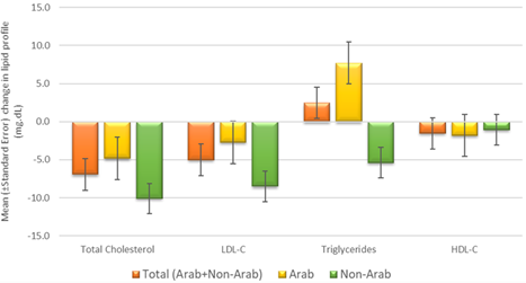Abstract
Ethnicity is a variable in statin response, but the influence of it in Arabs and South Asians is not known. There is a possibility of under-treatment in the long-term management of dyslipidemia in the Arab population, ignoring post-initiation medication nonadherence and lifestyle. There could be potential genetic reasons also for the need for higher lipid-lowering therapy in Arabs. This study is to identify lipid profile outcome gaps of Arabs and South Asians who were receiving chronic statin therapy. A hypothesis generating retrospective cohort study was conducted to compare lipid profiles among patients treated with a statin for more than three months. The study compared two lipid profiles of Arab and South Asian patients on chronic management of dyslipidemia. T-test and Z-test were performed to compare the lipid profiles. The study participants included 42 Arabs and 28 South Asians. Arabs had a higher body mass index (P-value 0.05), and more of them were smokers compared to South Asians (P-value 0.04). Total cholesterol (P-value 0.03, 95%CI 1.08 to -21.29) and LDL cholesterol (P-value 0.03, 95% CI 0.51 to -17.51) reductions in 3 – 6 months were significant in South Asians, but not in Arabs. The lipid profiles in Arabs receiving chronic statin therapy might be poor compared to South Asians. Both populations need improvements in lipid-lowering therapy outcomes. This hypothesis should be studied further to prove inherent differences and poor therapy outcomes among Arab and South Asian population that might result in modifications in current healthcare management policies.
Full text article
Authors

This work is licensed under a Creative Commons Attribution-NonCommercial-NoDerivatives 4.0 International License.

